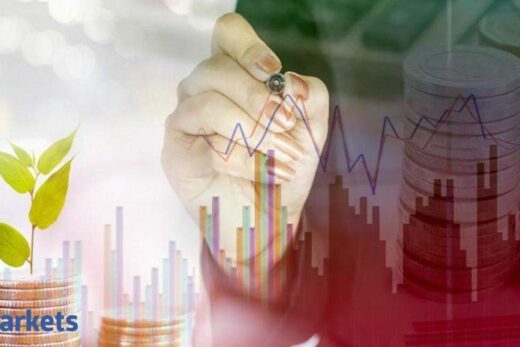Let’s start with the big picture and the big picture is that for a market where three months ago we were struggling to find a fault line, suddenly a lot of cracks are opening up. Cracks on the macro front, cracks on the commodity front and also cracks coming up on the interest rate and inflation side.
Quite possible. A market always has a narrative. The momentum in the market was very strong and we started painting narratives on growth, on rates. The risk was always there. When we looked around, we saw things were not so great. The markets have run up quite a bit and they are coming off and it has still been a fantastic year. Investors are making crazy returns, especially down the market. So I am not surprised, nor should you be.
How much of the underlying gains will sustain? Based on what we have heard from companies on the forward looking commentary, should one be realistic or optimistic?
There is definitely reason to be optimistic. A single variable does not define valuations. Valuations are a function of growth, the cost of equity and return on capital. The last part is kind of correlated to both growth and cost of equity. So the narrative on growth is meaningfully positive. If you look at the growth between say FY22 expectations vis-à-vis FY19 which is pre-Covid year, this is the highest growth that we have seen in many years. I would not have expected it at least when Covid happened.
So the narrative on earnings is positive and then there are these schemes that the government has introduced which gives a boost to the capex cycle — much easier fiscal and monetary policy. So the narrative on earnings is positive. You got the aspect of cost of equity which is also positive because rates have gone down. The real question to ask is how much of that earnings growth is sustainable and how much of this fall in yields is sustainable. Will yields go up again? It is a little complicated to answer that question. Are markets expensive? Yes. Should they correct? Yes. How much will they correct and at what level should you start buying? For that you need to answer what is the sustainability of growth? What is the sustainability of this interest rate environment, what is the probability of some external shock hitting the currency and impacting rates or inflation for that matter? So it is a little more complicated to arrive at the level of the market at which you start buying.
Can you broadly walk us through pockets where excesses are built up? Narratives are strong but the underlying current of the earnings is not strong or valuations are super stretched. Can you suggest a pocket or few ideas where markets will be positively surprised?
As in sectors or themes?
Let us talk about themes because with sectors one cannot have a generalised approach.
There is the primary market theme (IPO), which is definitely overheated. But is the primary market a homogenous theme? Maybe it is, because retail flows are driving primary market issuances and the money that you make on listings. But these are all different companies at different points in time and the market has also been making a bit of distinction there.
Then there is the technology theme outside IT services — the whole internet space, the disrupting space. That is a theme where I see people getting very excited. I have heard terms like valuation agnostic which is so ridiculous but that is the theme that is getting heated up possibly because it has worked very well in developed markets. Also, this whole China thing that is happening is probably driving investors from China to India looking for the next big opportunity. That theme is probably a bit homogenous but it is still all over the place. So I guess these are two obvious themes that seem exuberant right now. I cannot think of any right away.
How do you read into the commentary coming in from the US? Many people said that this bull run that we have seen in the markets is primarily on account of this massive surge in liquidity. Now if the US says they are ready to pull the plug, slowly and steadily, starting as early as perhaps next month, is this something that could spook us? Also, there is resurgence in cases in China, in the US and in pockets here and there. Could that prompt central banks to postpone their hawkish stance?
It is a weird world. We are talking about the whole tapering thing. People in this financial world have screwed up English also, taper means something goes down in width. We had talked about taper close to 10 years back, we are again talking about taper. There has been this belief in the markets, especially the US markets, that the central banks can do whatever they want. They can keep printing money and they can manage the whole dilemma around inflation and growth and keep this running. Somewhere we call it the monetary theory. But I do not know, we should definitely be worried about it.
Is this the time when central banks lose their ability to do whatever they have been doing all these years? I am not so sure. In fact, there is a very interesting comment that this guy Rahul, who works on the sell side sent me. If you think about it philosophically or technically or conceptually or whatever, can you really owe money in a currency that you alone have the right or the legal authority to print? This is exactly what is happening in the US. They print money and there is nothing all of us can do about it. So will that run continue? I do not know. Is it risky? Definitely, very risky and these are uncharted territories. I would be really worried because I am old school I guess.
The market breadth is going to get really narrow. One has to be very picky about what you buy from here on. What would you look at when you go stock picking for some of the SBI funds?
Okay, let me admit here, our job is much easier. We are relative return investors, we just need to outperform the benchmark. The questions that you are asking, I really do not have to think about them beyond a point because if the market falls, I will also fall. I just need to outperform. From that perspective, it is relatively easier and that is a big deal because with this kind of a view, I would have got screwed completely.
Now coming to stock selection yes, that is what we have done all these years and we have a large team and we just focus on trying to figure whether the business that we are buying is a good business and we keep evaluating that on a constant basis.
A good business is defined by some advantages — return on capital, growth, the longevity of growth, the management in terms of track record and we connect the whole investment thesis to what kind of price we pay. If one keeps doing that, the sources of alpha will change depending on the momentum in the market but it keeps active investing relevant forever.
In recent times when you are doing the stock picking and looking at sectors, what are the new pockets that you have found interesting that could give you the kind of returns that you are seeking?
Right now, I am short of ideas to be very honest. We are running a defensive portfolio. The stocks that we like are pretty expensive and the kind of assumptions that we need to make in terms of extending the high growth period or attributing significant market share gains and returns on capital sustaining at higher levels, one is not really comfortable with. I should not name stocks I guess, it is easier when you talk about stocks.
So the names that we like are expensive and the high growth pockets that are coming in, which are very interesting in terms of disruption. They are crazy in terms of what they are looking for. There is not an easy answer to it. I am sorry, I do not know how to answer that question. I mean there are no predominant names.
Let us talk about two or three sectors; one which is full of excitement, the other which is full of stress like pharmaceuticals. Right now, nobody wants to buy pharma stock because prices have collapsed and generic issues are there. Is this a good time to buy the stress into pharma or is there a structural issue with pharma pricing in the generic business like we saw between 2016 and 2018 or 2015 and 2017?
I think that issue has abated in pharma. It is a very interesting sector to look at; one, because of issues like consolidation on the US front and the generic pricing issues have abated. Secondly, pharma as a sector has not really performed pre Covid, for a pretty long time. The initial part of the rally was pharma catching on to the earlier underperformance effectively and this whole crisis has given a boost to pharma in a different space.
The stocks that we have owned for a very long time like Divi’s and
, are businesses where you have seen very significant momentum. I am not talking of the stock price. These are businesses where we have seen substantial profit growth, way above what we were expecting in our wildest imagination and these companies are now investing big time. Look at the capex plans. They are investing big time and companies invest if they see visibility of growth. Even the probability of that visibility is now much higher because of the whole China plus one thing in APIs or intermediates of specialty chemicals.
We have the stocks that we like and on the larger funds we are still playing this basket. I am not sure how effective this basket will be. It has worked well for us, I would say. The whole compliance around the pharma companies, the requirement may not have come down but the pace at which they come out with the vaccine — mRNA for example is not even tested on humans — it tells the world that we are okay with going ahead since this is the need of the hour. I do not know whether that should lead to a rerating. That is something to think about, I guess.
In next three to five years, do you think a basket of traditional consumer companies like HUL, Nestle, Britannia will outperform a basket of new tech consumer companies whenever the basket is ready starting with (with Policybazaar, Nykaa and others joining later).
We have debated this question. I do not like consumer companies like Lever and Nestle. They are quite expensive. I do not mind paying if there is growth and growth in these segments have saturated, they are still single digits, somewhere higher single digits but if you want 15% returns, these are not companies which can rerate from here. So, this is an interesting proposition to shift to other expensive names where there is growth.
Now the problem is how do you think about valuations? When I think about valuations, I think about it in terms of the sustainable profits. I will obviously pay a significant premium because of the growth that is happening on account of the disruption from offline to online, but a very important aspect is whether these businesses have competitive advantage, whether they will sustain and actually start making this money? Once they start making money will they be able to continue making that money and what will define them making this kind of an annuity is the effectively the competitive advantage.
Why does Lever make money? Lever makes an infinite return on detergents or soaps because you buy a brand and you pay a premium and that premium gives the entire profitability. Now do the new tech consumer companies have that or can somebody else come and disrupt the existing disruptor? These are very relevant questions and these are very stock specific. I am extremely sceptical about a lot of these new businesses that are coming up/
I actually feel good when we reject some of this because it just does not add up but it is again very stock specific in terms of what you want to buy. I would not play this as a team for sure, I would not just switch from the consumption or the consumer staple basket you are talking about to new age companies as a theme without being stock specific on the underlying business.
In the market, some are excited about ethanol-related companies, some are bullish about what is happening in the EV business, some are excited about ESG. How much of that is hot air and how much of that is realistic?
Let me answer this question differently. We run this focussed fund which is ESG compatible, but it is not called an ESG fund. E is a very inherent aspect of figuring out how to access the business. E means if there is environmental disruption, it will lead to that business shutting down effectively. If you look at something like thermal power or two-wheelers in this era, these businesses are getting disrupted and that means the money they are making will no longer be there beyond a point and one has to be worried about that.
You should not buy these businesses because you cannot paint an annuity stream. A business that gives you an annuity stream — even if you apply 10% cost of equity — gives it 10 times multiple.You do not give it 30-40 times multiple and if this annuity stream itself is going to stop and go down, what is the multiple it can get? It has to be lower than 10.
Then there is this G part. G is always governance. It has always been a very inherent intrinsic part of our stock selection process. We have a forensic model which runs some 16 variables across some 600-650 odd companies and our analyst discusses each of the red flags and question and figures out why that is so w– be it miscellaneous expenses as a percentage of sales or it is the auditors. So, G was always a part here, this is not something new but ESG definitely is a buzzword. S or social is something which is still evolving. But these are issues that as investors we always thought about. Now there is a term to it. The philosophy may have gone mainstream but a lot of them have been relevant for a very long time.
What about EVs?
Those are cyclical themes that keep coming up. You have to look at businesses which will make money out of it. It is very specific to a sector and it is thematic or cyclical.



